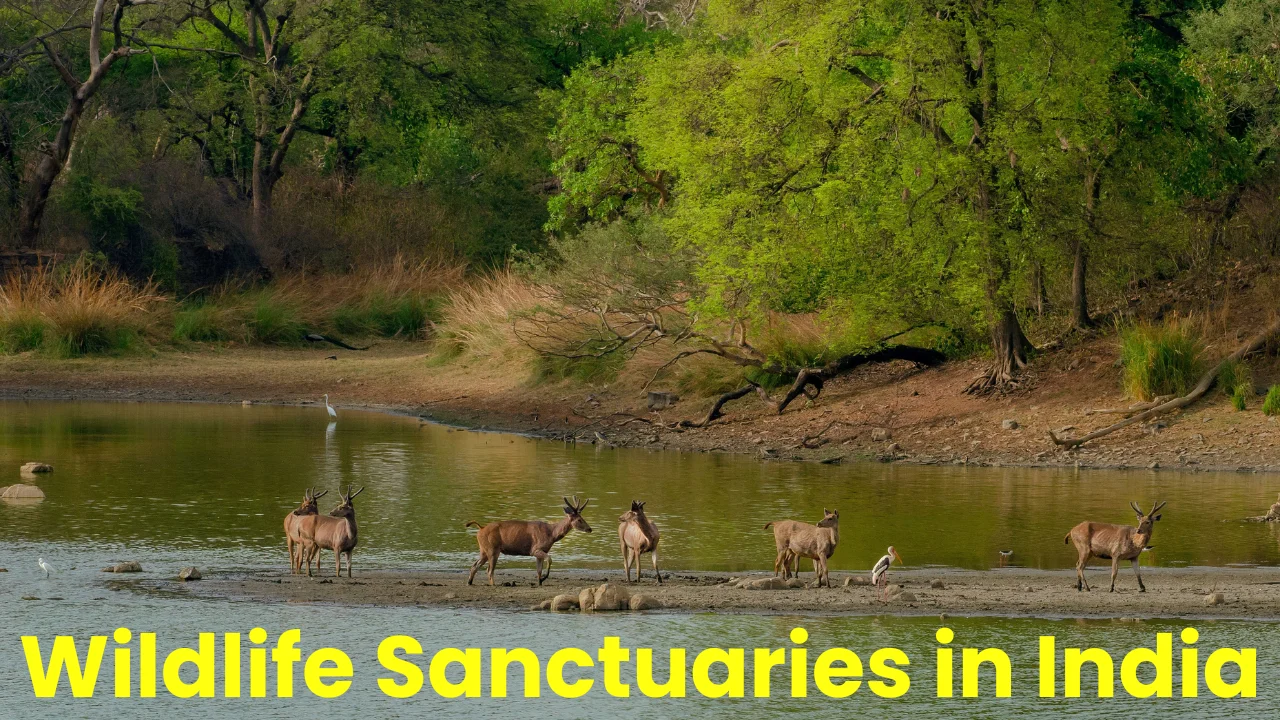Wildlife Sanctuaries in India 2024
India boasts a remarkable network of wildlife sanctuaries, safeguarding diverse ecosystems and captivating creatures across the nation. As of 2024, over 573 sanctuaries exist, encompassing a vast 123,762.56 km2, which is 3.76% of the country’s geographical area (National Wildlife Database Centre, Nov. 2023). Another 218 sanctuaries are proposed in the Protected Area Network Report covering an area of 16,829 km2. These refuges shelter a kaleidoscope of endangered and endemic species, beckoning nature enthusiasts and conservationists alike.
Statewise List of all Wildlife Sanctuaries in India
| States & UTs | State Area (km²) | No. of WLS | Area (km²) | % of State Area |
| Andhra Pradesh | 160229 | 13 | 6771.40 | 4.23 |
| Arunachal Pradesh | 83743 | 13 | 7614.56 | 9.09 |
| Assam | 78438 | 17 | 1728.95 | 2.20 |
| Bihar | 94163 | 12 | 2851.67 | 3.03 |
| Chhattisgarh | 135191 | 11 | 3760.28 | 2.78 |
| Goa | 3702 | 6 | 647.91 | 17.50 |
| Gujarat | 196022 | 23 | 16618.42 | 8.48 |
| Haryana | 44212 | 7 | 118.21 | 0.27 |
| Himachal Pradesh | 55673 | 28 | 6115.97 | 10.99 |
| Jharkhand | 79714 | 11 | 1955.82 | 2.45 |
| Karnataka | 191791 | 38 | 8216.69 | 4.28 |
| Kerala | 38863 | 18 | 2156.21 | 5.55 |
| Madhya Pradesh | 308245 | 24 | 7046.19 | 2.29 |
| Maharashtra | 307713 | 49 | 7861.70 | 2.55 |
| Manipur | 22327 | 7 | 708.14 | 3.17 |
| Meghalaya | 22429 | 4 | 94.11 | 0.42 |
| Mizoram | 21081 | 9 | 1359.75 | 6.45 |
| Nagaland | 16579 | 4 | 43.91 | 0.26 |
| Odisha | 155707 | 19 | 7094.65 | 4.56 |
| Punjab | 50362 | 13 | 326.60 | 0.65 |
| Rajasthan | 342239 | 25 | 5592.38 | 1.63 |
| Sikkim | 7096 | 7 | 399.10 | 5.62 |
| Tamil Nadu | 130058 | 33 | 7096.54 | 5.46 |
| Telangana | 114840 | 9 | 5672.70 | 4.94 |
| Tripura | 10486 | 4 | 603.64 | 5.76 |
| Uttar Pradesh | 240928 | 26 | 5822.20 | 2.42 |
| Uttarakhand | 53483 | 7 | 2690.12 | 5.03 |
| West Bengal | 88752 | 16 | 1440.18 | 1.62 |
| Andaman & Nicobar | 8249 | 97 | 395.60 | 4.80 |
| Chandigarh | 114 | 2 | 26.01 | 22.82 |
| Dadra & Nagar Haveli | 491 | 1 | 92.17 | 18.77 |
| Daman & Diu | 112 | 1 | 2.19 | 1.96 |
| Delhi | 1483 | 1 | 19.61 | 1.32 |
| Jammu & Kashmir | 163090 | 14 | 1815.04 | 1.11 |
| Ladakh | 59146 | 2 | 9000.00 | 15.22 |
| Lakshadweep | 32 | 1 | 0.01 | 0.03 |
| Puducherry | 480 | 1 | 3.90 | 0.81 |
| TOTAL | 3287263 | 573 | 123762.56 | 3.76 |
Most Famous Wildlife Sanctuaries in India
Defining “most famous” can be subjective, depending on factors like popularity, specific wildlife highlights, and individual preferences. However, here are some of the most well-known and frequently sought-after wildlife sanctuaries in India, catering to diverse interests:
Tiger encounters
- Ranthambore National Park, Rajasthan: Famed for its high tiger density and scenic backdrop, Ranthambore offers thrilling jeep safaris and opportunities to spot tigers basking in the sun or prowling through the forests.
- Kanha National Park, Madhya Pradesh: This vast Sal forest sanctuary boasts a thriving tiger population along with herds of spotted deer, barasingha, and sloth bears, making it a paradise for wildlife enthusiasts.
- Jim Corbett National Park, Uttarakhand: The birthplace of Project Tiger, this park holds historical significance and offers jeep safaris and elephant rides through diverse habitats, increasing the chances of encountering tigers and other mammals.
Diverse Wildlife
- Kaziranga National Park, Assam: A UNESCO World Heritage Site, Kaziranga is the prime destination for spotting the one-horned rhinoceros, along with Asian elephants, tigers, and a plethora of bird species.
- Periyar Wildlife Sanctuary, Kerala: Nestled in the Western Ghats, this sanctuary shelters Asian elephants, gaur, tigers, and vibrant birdlife, offering scenic boat rides on Periyar Lake and jungle walks amidst lush greenery.
- Gir National Park, Gujarat: Home to the majestic Asiatic lion, Gir boasts dry deciduous forests and diverse wildlife including leopards, hyenas, and numerous bird species.
Unique Experiences
- Sundarbans National Park, West Bengal: This unique mangrove forest sanctuary protects the Bengal tiger, offering boat safaris through tidal creeks and witnessing the intricate ecosystem where land meets water.
- Dandeli Wildlife Sanctuary, Karnataka: Situated along the Kali River, Dandeli offers thrilling white-water rafting amidst dense forests, along with opportunities to spot sloth bears, leopard cats, and various bird species.
- Pangong Tso Wildlife Sanctuary, Ladakh: Immerse yourself in the stark beauty of the Himalayas, spotting marmots, kiangs, and migratory birds against the backdrop of the breathtaking Pangong Tso lake.
This list is just a starting point, and countless other fascinating sanctuaries await exploration in India. Let me know what kind of wildlife or experiences you’re interested in, and I can help you discover the perfect sanctuary for your next adventure!
First Wildlife Sanctuary in India – Jim Corbett National Park
Determining the “first wildlife sanctuary” in India requires some clarification, as there are two possible interpretations:
1. Earliest established protected area: In this sense, the title belongs to Vedanthangal Bird Sanctuary, located near Chennai in Tamil Nadu. Established in 1796, it initially aimed to protect a specific bird, the Indian roller, making it the earliest designated protected area for wildlife in India.
2. First sanctuary under the Wildlife (Protection) Act, 1972: Under this definition, the Hailey National Park, later renamed Jim Corbett National Park in Uttarakhand, claims the title. Established in 1936, it became the first wildlife sanctuary designated under the Wildlife (Protection) Act of 1972, which set the legal framework for wildlife conservation in India.
Both hold historical significance in India’s wildlife conservation journey, representing different starting points in the evolution of protected areas. If you’d like to know more about either of these sanctuaries or understand the different types of protected areas in India, I’d be happy to elaborate!
The Latest Wildlife Sanctuary in India – Karimpuzha Wildlife Sanctuary
The Karimpuzha Wildlife Sanctuary, situated near Nilambur in the Malappuram district of Kerala, was officially declared a wildlife sanctuary on July 3, 2020. Covering an expansive area of 227.97 km2, it encompasses the New Amarambalam Reserved Forest and Vadakkekotta vested forest, excluding the Manjeri colony of the Cholanaikar tribe. This sanctuary is a crucial part of the Nilgiri Biosphere Reserve.
One of the significant roles of the Karimpuzha Wildlife Sanctuary is connecting the Silent Valley National Park in Kerala with the Mukurthi National Park in Tamil Nadu, creating a contiguous protective stretch. Additionally, it shares borders with the Mukkuruthi National Park in the south and the Silent Valley National Park buffer zone in the northeast.
Known for its rich biodiversity, the sanctuary houses various mammals endemic to the Western Ghats, including the Nilgiri Tahr and Lion-tailed macaque. This makes it a vital conservation area for preserving the unique flora and fauna of the region.
Importance of Wildlife Sanctuaries
Wildlife sanctuaries play a crucial role in protecting our planet and its inhabitants. Their importance can be understood through various lenses:
1. Conservation of Species:
- Safe Haven for Endangered Animals: Sanctuaries provide a haven for vulnerable and endangered species, shielding them from threats like poaching, habitat loss, and human encroachment. This helps prevent extinction and allows populations to recover.
- Habitat Protection: These protected areas preserve natural habitats, ensuring critical resources like food, water, and shelter are available for wildlife to thrive. This also protects the delicate ecological balance that supports diverse ecosystems.
2. Environmental Benefits:
- Maintaining Biodiversity: Sanctuaries safeguard a wide range of plant and animal species, promoting biodiversity. This biodiversity is crucial for healthy ecosystems, which provide clean air, water, and fertile soil for human well-being.
- Combating Climate Change: Intact ecosystems play a vital role in mitigating climate change. Sanctuaries help protect forests and wetlands, which act as carbon sinks and regulate water cycles, contributing to a healthier planet.
3. Educational and Research Opportunities:
- Living Laboratories: Sanctuaries offer valuable opportunities for scientists to study wildlife behavior, ecology, and conservation needs. This research informs effective conservation strategies and helps us understand the interconnectedness of nature.
- Raising Public Awareness: Visiting sanctuaries can inspire people of all ages to appreciate and learn about wildlife. This fosters environmental consciousness and encourages responsible actions towards conservation.
4. Economic and Cultural Benefits:
- Sustainable Tourism: Responsible wildlife tourism in sanctuaries can generate income for local communities and support conservation efforts. This creates a positive relationship between humans and wildlife.
- Cultural Heritage: Sanctuaries often encompass culturally significant landscapes and traditional ecological knowledge. Protecting these areas preserves our cultural heritage and the wisdom of indigenous communities.
Overall, wildlife sanctuaries are vital for the health of our planet, its biodiversity, and our well-being. By protecting these havens for wildlife, we ensure a future where humans and nature can co-exist in harmony.
- RBI SO Syllabus and Exam Pattern 2025 for Grade A and B
- RBI SO Eligibility 2025, Check Qualification & Age Limit
- RBI SO Exam Date 2025, Check Phase 1 Schedule for Grade A/B
- RBI SO Apply Online 2025 Before 31st July for 28 Vacancies
- RBI SO Notification 2025 Out for 28 Vacancies of Grade A & B
- Free SSC CHSL Topic Wise Tests for English, Quant & More, Attempt Now
FAQs: Wildlife Sanctuaries in India 2024
Ans. A Wildlife Sanctuary is a protected area designated for the conservation and preservation of wildlife, their habitats, and biodiversity. These sanctuaries serve as safe havens for various species of animals, birds, and plants, providing them with a secure environment where they can thrive without human interference.
Ans. As of 2024, over 573 sanctuaries exist, encompassing a vast 123,762.56 km2, which is 3.76% of the country’s geographical area (National Wildlife Database Centre, Nov. 2023).

Hello, I’m Aditi, the creative mind behind the words at Oliveboard. As a content writer specializing in state-level exams, my mission is to unravel the complexities of exam information, ensuring aspiring candidates find clarity and confidence. Having walked the path of an aspirant myself, I bring a unique perspective to my work, crafting accessible content on Exam Notifications, Admit Cards, and Results.
At Oliveboard, I play a crucial role in empowering candidates throughout their exam journey. My dedication lies in making the seemingly daunting process not only understandable but also rewarding. Join me as I break down barriers in exam preparation, providing timely insights and valuable resources. Let’s navigate the path to success together, one well-informed step at a time.






